What Procedures Are Done in a Cath Lab?
This article has been updated 17-07-23
Most X-ray devices are used for medical diagnosis, but for certain procedures the units can be both diagnostic and interventional. Among these belong mobile C-arms and cath lab systems.
We have written about the use of mobile C-arm machines, but what procedures are done in a cath lab, and when would you use a cath lab rather than a mobile C-arm?
Let us take a look.
What is a Cath Lab?
Cath lab, short for catheterization laboratory, is an examination room in a hospital or clinic with diagnostic imaging equipment.
It is similar to a C-arm except that it is not mobile but a mounted system with a table. It also has more power than a mobile C-arm.
But, what is done in a Cath lab?
In a cath lab, physicians perform minimally invasive tests and procedures to diagnose and treat, for example, cardiovascular diseases.
The procedures performed in a cath lab often include small, flexible tubes, called catheters that are used instead of open surgery, to access the heart and blood vessels.
In general, cath labs consist of:
- Patient table
- Image intensifier / Flat panel detector
- Viewing monitors
- Injector pump
- Angioplasty balloons
- Defibrillator
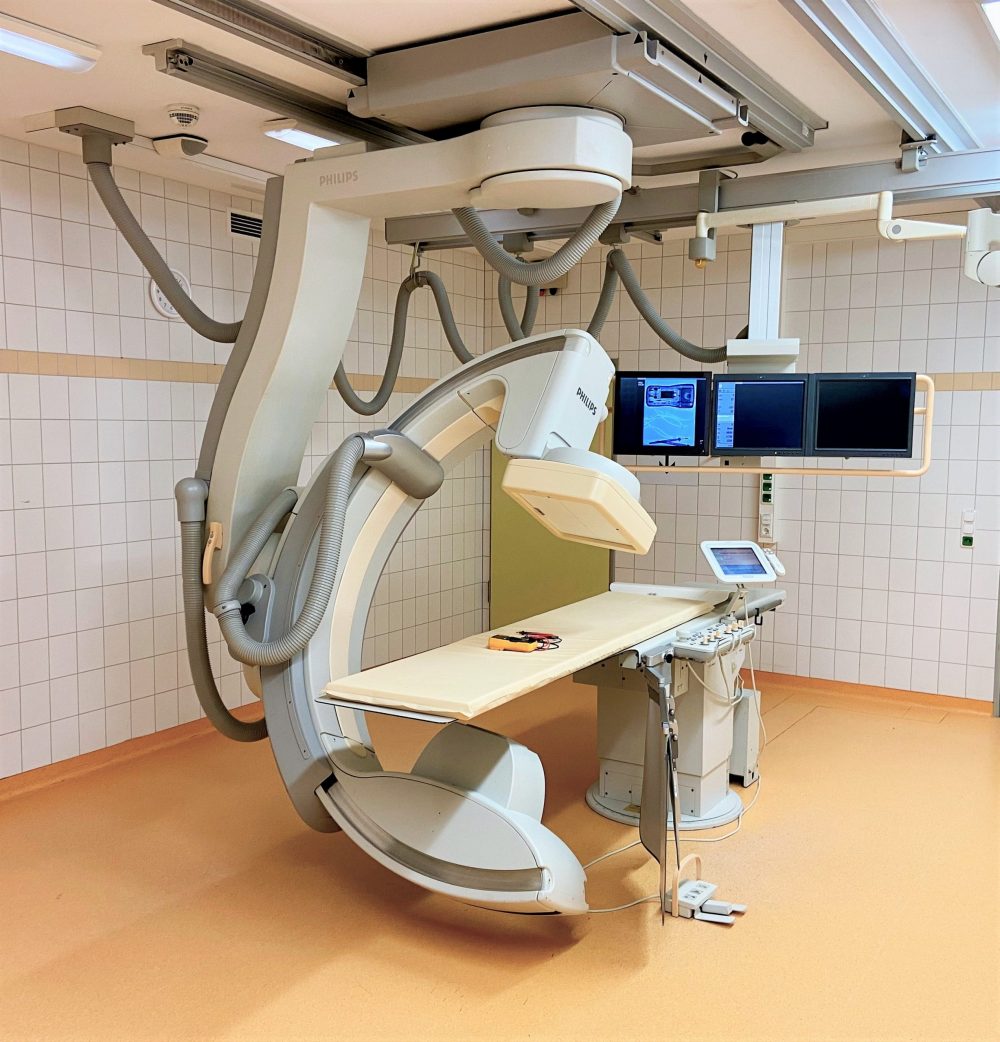
Most cath labs have a single X-ray generator source and X-ray image intensifier for fluoroscopic imaging. Those are single plane cath labs, either floor or ceiling mounted.
Older cath labs use cine film to record the information (these are analog cath labs). However, since the early 2000’s, most new facilities have gone digital.
In the market, there are also bi-plane or dual plane cath labs. Dual cath labs have two C-arms, where either both are ceiling mounted or one is ceiling and the other is floor mounted.
This means that the cath lab uses a dual X-ray source as well as a dual detector that allow simultaneous two plane visualization in, for example, coronary procedures.
Most top providers of medical imaging equipment also manufacture cath labs. You can find cath labs from GE, Philips, Siemens as well as Canon Medical (former Toshiba).
What Procedures Are Done in a Cath Lab?
There are various cath lab uses.
But, typically, you would use a cath lab for:
- Cardiac procedures
- Vascular procedures
- Angiography procedures
- Neurology procedures
The different types of interventional work require different characteristics of the cath lab. Nevertheless, the most important determinants to help you decide which cath lab fits your needs are:
- Whether the system is single plane or bi-plane
- Floor or ceiling mounted
- And the size of the detector
Let us discuss these in more detail.
What Is the Difference between Single Plane and Biplane Cath Labs?
First of all, bi-plane cath lab systems acquire 3D images faster than single plane cath labs. This is particularly useful in procedures such as neurology and cardiac.
Bi-plane systems can acquire 3D images faster because they capture image data from detectors on two axes instead of just one.
Even though single plane cath labs (picture on the left) are also capable of 3D imaging, it takes longer for the C-arm to move. And thus, the software’s reconstruction process can cause delays.
Moreover, bi-plane cath labs come with the 3D software as a standard, while it must be added to the single-plane systems.
Another difference is in the site preparation. A bi-plane cath lab is basically a double C-arm, therefore, you need more space as well as more time to have the site ready for your cath lab.
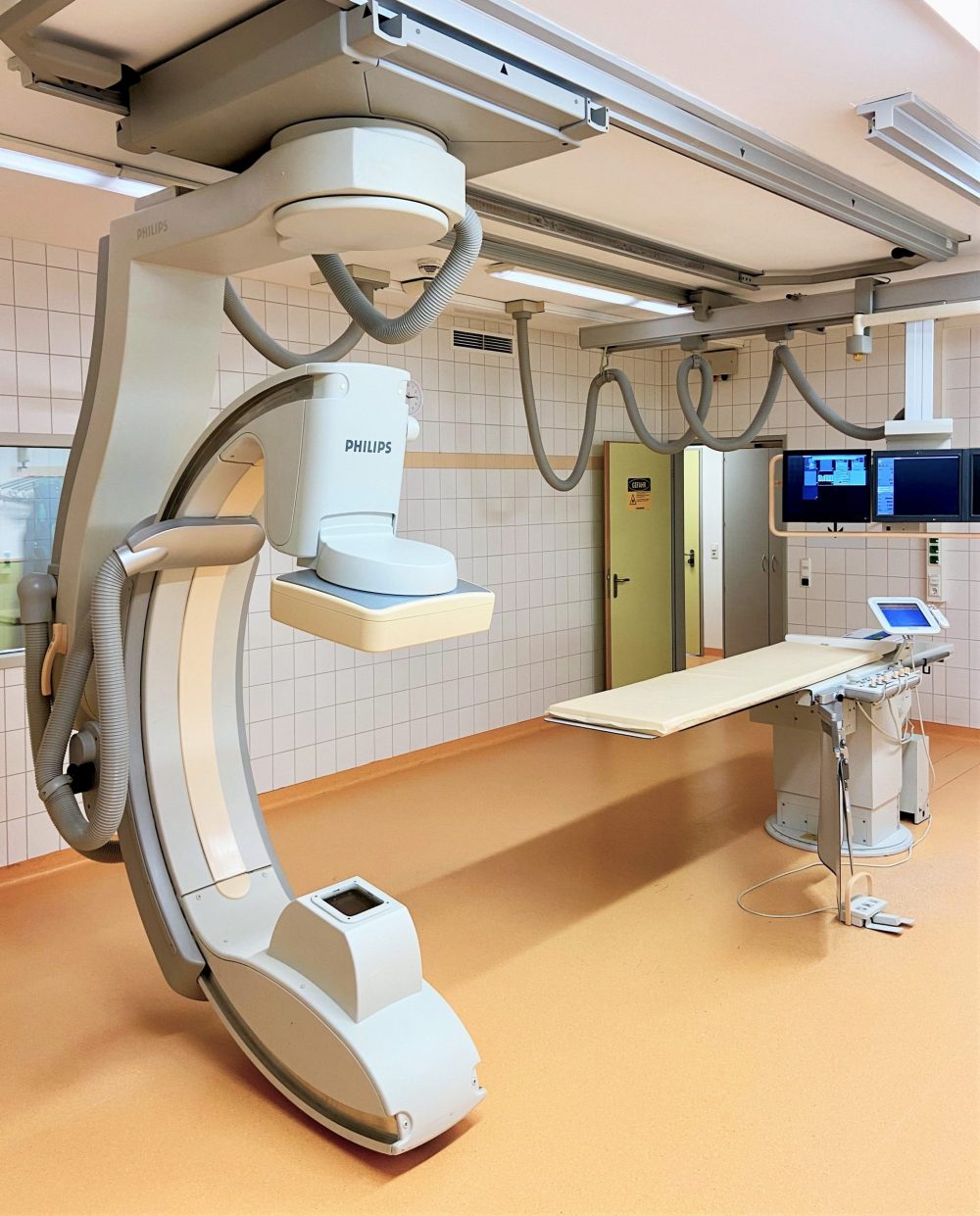
It is necessary to install both the floor mount and the ceiling support, hence, more work is required. Also, the bi-plane cath lab has a larger overall footprint.
Lastly, the price of the bi-plane system is higher. Especially because it comes with more components. The construction and operation costs can be double that of a single-plane system, while service costs are 25% to 30% higher.
In general, bi-plane cath labs give you the flexibility of simultaneous visualisation from two planes. And thus, you can see more during the procedure. However, they are not very common, because overall you can get similar performance from single plane cath labs at a much lower price.
See an easy overview of pros and cons of single and bi-plane cath labs below.
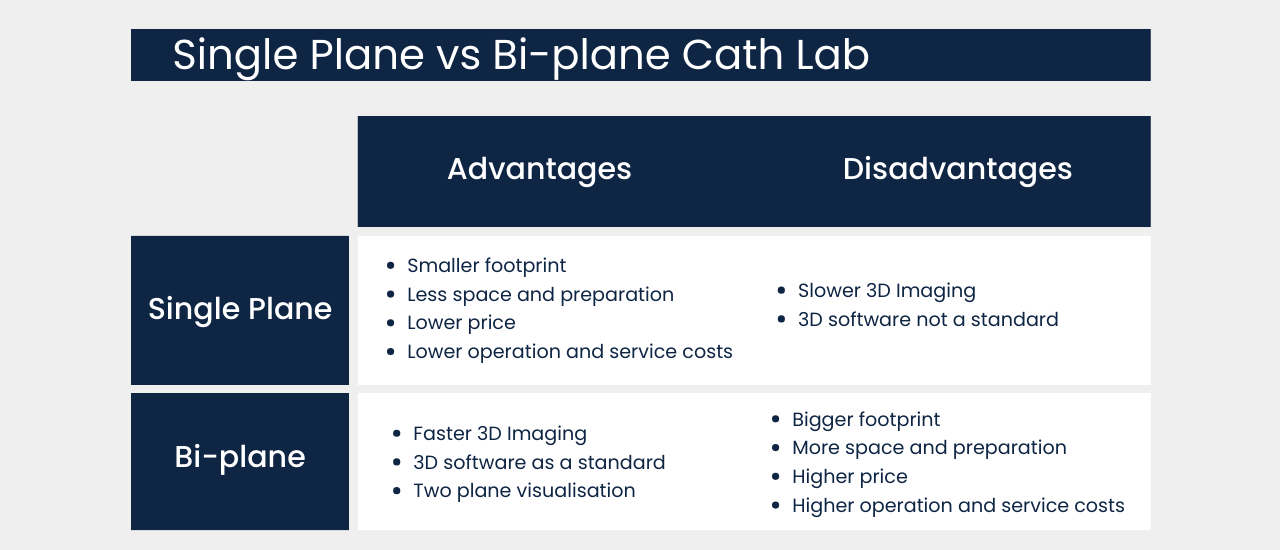
How to Pick the Size of a Cath Lab Detector?
You should choose the detector size based on the type of work you will perform with the system the most.
Cath labs with smaller detectors (20 cm) are preferred for cardiac and pure neurological procedures. 30 cm detectors are considered a “combo” and can perform both cardio and vascular studies.
Finally, 40 cm detectors are recommended for angio, as the field of view provides better abdominal and lower body vascular studies.
Floor Mounted or Ceiling Mounted Cath Lab?
Apart from single or bi-plane, cath labs can be either ceiling or floor-mounted.
There are different factors determining the decision whether to get a floor or ceiling mounted cath lab. You need to consider your workflow, room space as well as the procedures you are planning to do with your cath lab.
For your information, both floor (photo on the left) and ceiling-mounted (photo on the right) cath labs require some form of ceiling structure to hang the overhead monitor’s suspension.
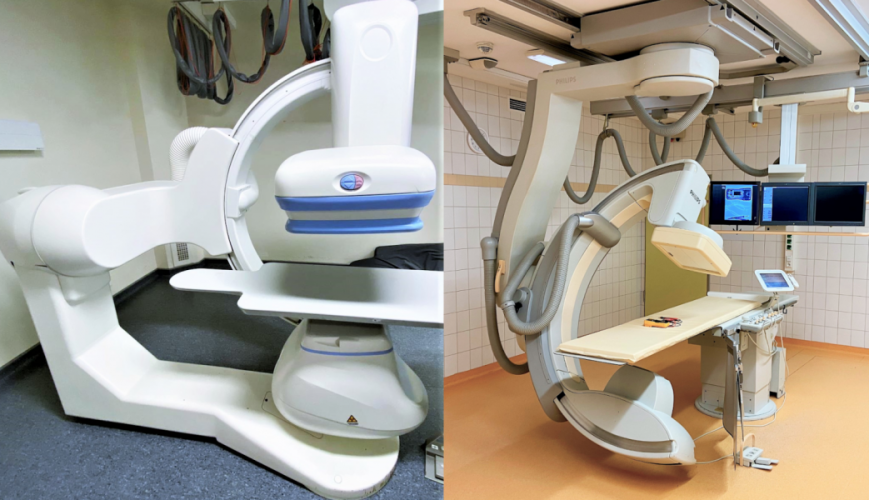
What is the difference between ceiling and floor mounted cath labs?
Firstly, ceiling-mounted systems (such as the Allura Xper FD20 from Philips) suspend the gantry or “C” from the ceiling and require a much more robust structure to hold its considerable weight.
Also, ceiling-mounted systems require rooms with higher ceilings. That is to provide floor clearance for the gantry in its lowest position.
Therefore, if you are about to install the cath lab in an existing building, the choice of mounting method may be affected by your current ceilings and floors.
What more?
Hospitals and other practices considering a ceiling-mounted cath lab should allocate higher budget for this project. That is due to the reinforced suspension the system will require, which can cost around 10.000 euros.
Lastly, keep in mind that not all manufacturers offer a ceiling-mounted option for single-plane systems. For instance, all GE single-plane cath labs are floor-mounted. An example is the GE Innova 3100 IQ and Innova 2100 IQ.
Mobile C-Arm vs Cath Lab Explained
It can be confusing when to use cath labs rather than mobile C-arm machines.
So, here is mobile C-arm vs. cath lab explained.
These two fluoroscopy systems can both be used for interventional procedures. You will benefit from both systems, but each has strengths in certain procedures and settings.
It is essential to make sure that you have the right tool for the work you want to do.
Where do C-arms and cath labs differ?
During longer or more advanced studies that require longer fluoro, you may need the power of the cath lab.
For same-day vascular or cardiac procedures, with a low patient load, a mobile C-arm with rotating anode tube, the right options, and surgical table can be used as a “light” cath lab.
And when it comes to features of these two fluoroscopy machines?
In general, cath labs are richer in functions. Cath labs come with post-processing options, table-side controls, and multiple review stations – none of which would come with a mobile C-arm machine.
One of the advantages of the C-arm is its mobility. Also, it can be set up in an hour, while the installation of a cath lab will take about 2 weeks.
And what about the price of these systems?
In general, used mobile C-arms cost less than cath labs, used C-arms can cost from 10.000 euros up to 90.000 euros. On the contrary, used cath labs prices are around 100.000 euros.
However, there are many factors to consider – analog vs digital, system age, model. All of these can make the systems more or less expensive up front.
However, regarding ongoing costs, cath labs will become more pricey. It is a larger piece of equipment with more components. New cath labs cost around 400 – 500.000 euros.
Therefore, a pre-owned, fully tested and installed cath lab at half that price can be a cost-effective solution. Furthermore, it allows you to buy a system from top brands at a better price.
In the table below, we sum up the benefits that mobile C-arms and Cath labs provide.
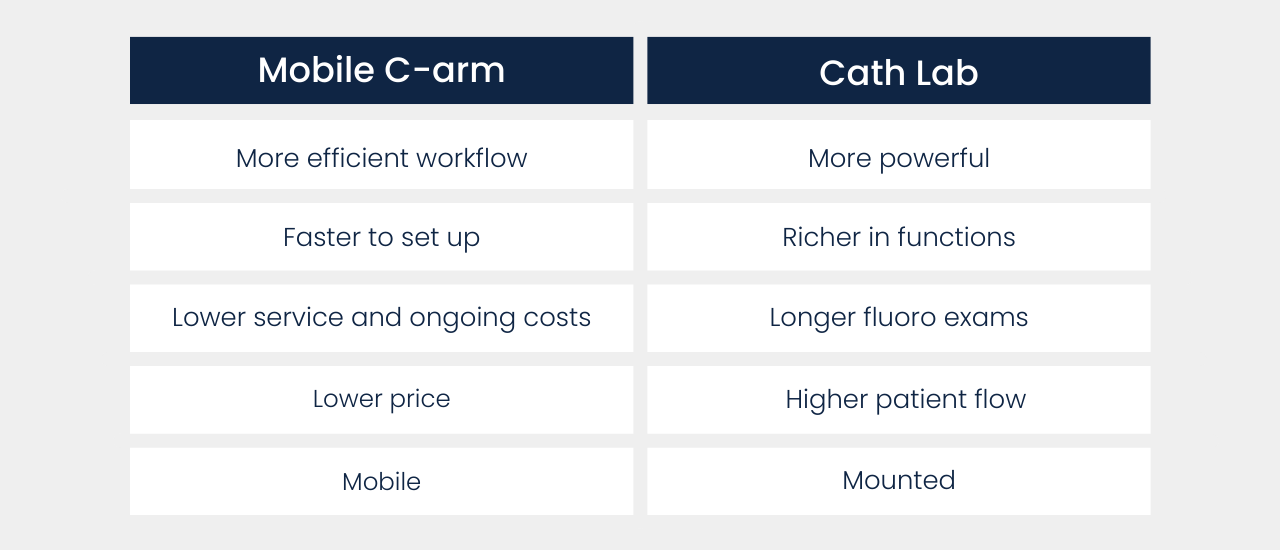
Sum Up – How to Pick the Right Cath Lab?
To pick a cath lab that fits your needs, be clear on these questions:
What procedures are done in a cath lab?
Most often, you would use a cath lab for cardiac, vascular, angiography, and neurology interventional procedures.
What cath lab detector to use for different types of examinations?
What is the difference between a single and bi-plane cath lab?
How do mobile C-arm machine and cath lab differ?
If you have questions that we have not answered, please get in touch.
You can also check our inventory of Cath lab machine parts.
And what is next?
If you would like to learn even more about cath labs and other medical imaging equipment, sign up for our newsletter. We bring you new insights and the best offers every month.